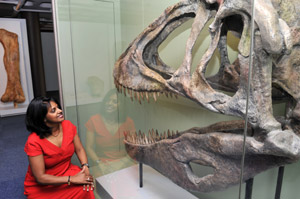New paper on bizarre-looking reptile
17 March 2008 |
| New light on old bones: Prof Anusuya Chinsamy-Turan and her co-authors have published a paper in Biology Letters on Pterodaustro. |
Palaeobiologist Professor Anusuya Chinsamy-Turan (Zoology) and two co-authors have published the first detailed palaeobiological examination of the now-extinct creature, Pterodaustro guiñazui, in the Royal Society's prestigious Biology Letters on 29 February.
A team of international scientists has been doing detective work on one of the more bizarre-looking creatures to grace the planet.
"This creature was called Pterodaustro and had a mouth that looked like a hairbursh, because of the thousand narrow teeth which were probably used to scoop microscopic organisms out of the water, much like modern flamingos," said Chinsamy-Turan, a dinosaur bone microstructure specialist.
"It belonged to the pterosaurs, the first group of vertebrates to evolve the ability to fly. It lived 140 million years ago in what is now Argentina. It had a wingspan roughly the size of a surfboard and would have flown over the herds of dinosaurs.
"Pterodaustro is a very unusual flying filter-feeder which we've known about since the early 1970s. Now, for the first time, we understand it as a living animal, its lifespan, whether it was more like a reptile or a bird. We know that it grew more slowly than a bird, but it stopped growing at a certain size, unlike most reptiles, which just keep getting bigger and bigger," said co-author Laura Codorniú, who is based in Argentina.
Co-author Luis Chiappe said: "That's interesting because until now most people thought these flying reptiles would be like modern birds, which grow very quickly and become mature in a matter of weeks. Yet we see many different sizes of Pterodaustro in the fossil record and this shows that they grew a lot slower - and now the bone microstructure has verified this."
 This work is licensed under a Creative Commons Attribution-NoDerivatives 4.0 International License.
This work is licensed under a Creative Commons Attribution-NoDerivatives 4.0 International License.
Please view the republishing articles page for more information.










